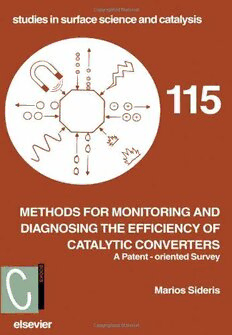
Methods for Monitoring and Diagnosing the Efficiency of Catalytic Converters PDF
465 Pages·1998·15.647 MB·English
Most books are stored in the elastic cloud where traffic is expensive. For this reason, we have a limit on daily download.
Preview Methods for Monitoring and Diagnosing the Efficiency of Catalytic Converters
Description:
The dramatic evolution of catalytic converters in the last thirty years was a result of a need worldwide to reduce pollution created by the exhaust gases of internal combustion engines. Environmental concerns have led American, Japanese and European Union (EU) legislation to pose continuously stricter emission limits for petrol engines in the last decades. The catalytic converter has become the most important means of exhaust treatment to achieve the desired emission limits. The international legislation has also created a need for a regular assessment of the efficiency of the catalytic converter in order to detect a deterioration of its conversion efficiency as soon as this deterioration takes place. The assessment of conversion efficiency of a catalytic converter can take place during normal driving of a vehicle (on-board diagnosis or OBD) or in a workshop by specialized technicians. The most important methods nowadays are the OBD methods. The evolution of methods concerned with OBD and non-OBD monitoring and diagnosing of efficiency of catalytic converters of internal combustion engines is described based on patents and published patent applications. Non-patent references are also used. The basic principles of modern catalytic converters are described in an extensive Introduction, where the importance of monitoring and diagnosing the efficiency of catalytic converters is demonstrated. The book is divided into four parts. The first part describes methods involving the use of oxygen or air/fuel exhaust gas sensors to determine the oxygen storage capacity of a catalytic converter. The second part describes methods involving the use of temperature sensors to determine the exothermic reaction capacity of a catalytic converter. The third part describes all other methods existing in patent literature that monitor and diagnose the efficiency of catalytic converters. The great majority of the methods of the third part involves exhaust gas concentration measurements. The fourth part comprises a general discussion of all methods described. In the beginning of each part, a short introduction is given to explain the problem that the methods attempt to solve. The methods in each part are presented in chronological order per patent applicant. This helps to evaluate how the patent applicant has improved his methods over time. A patent number index with information about the patent applicants, inventors, priorities and patent-families, an inventor index, a company index and a subject index can be found at the end of the book.
See more
The list of books you might like
Most books are stored in the elastic cloud where traffic is expensive. For this reason, we have a limit on daily download.
